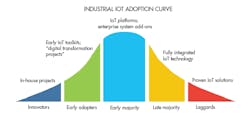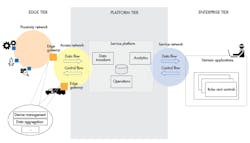Download this article in PDF format.
Sensors, controls, and network connectivity are now economically viable for ordinary products, not just high-value products. Every “thing” with an on-off switch can be reimagined as a smart, connected device. An internet-connected smartphone or tablet can be the control panel for every device, and the Internet of Things (IoT) is able to support monitoring, control, and function delivery in new ways:
Monitoring: The IoT concept separates data sensing from its analysis and presentation. IoT assumes that analysis of sensor data streams, not direct display, is more useful and cost-effective. The “thing”—say, a machine—is connected to the internet so that its sensor readings and their results after analysis can be accessed by any other authorized internet-connected device. This can be a smartphone or tablet on the other side of the world, or an AI system learning how to operate the machine.
Control: Before IoT, control commands originated from buttons, switches, and sliders on the control panel of a device, or from a remote equivalent of this panel. IoT can embed these commands in messages to the device. These messages originate from an internet-connected physical or virtual control panel anywhere, or from supervisory software running on any internet-connected system.
Function delivery: Embedded software in an IoT device has the option, subject to latency considerations, to work in conjunction with software on local or remote connected systems, to add functions ranging from administrative to artificial intelligence (AI). All of this software can be updated, with or without a technician’s visit.
Processes Reimagined
IoT capabilities can affect most activities in an engineering, manufacturing, and production business. For example:
- Factory operations: Single-screen display of real-time status, predictive diagnostics, and business system information can improve batch prioritization and scheduling.
- Engineering: Real-world usage feedback can calibrate analysis models and drive next version requirements.
- Commercial: Terms based on usage and performance are able to provide a competitive advantage.
- Sales: Insight into usage patterns can guide actions to offer appropriate additional products and services at the right time.
- Service: It’s possible to remotely deliver operation, diagnostics, and maintenance; analytics enable predictive maintenance.
Smart connected products offer remote monitoring and control as standard and in-service configuration plus software upgrade.
Business Model Reimagined
The scope of reimagination does not stop at products and processes; it also applies to the business model. For example:
- If waste containers can detect when they are nearly full, collection rounds can be scheduled as needed, not just after a fixed amount of time.
- If machines are able to report enough data, then suppliers can accept the risk – and gain competitive advantage – by selling contracts based on performance rather than the product.
Both of these examples allow the top managers of the organization to innovate the business model through “servitization”: Delivering a service based on a product, either as an extra, or as an alternative to selling the product.
Designing, Building and Operating an IoT Solution
There are two steps in an industrial IoT solution, and each requires different software:
- Designing and building the solution: Software tools are required to design, develop, test, and manage the hardware, software, production, delivery, and use processes for the product.
- Operating an industrial IoT system: An operational industrial IoT system involves some combination of the smart connected devices, the connectivity, and the servers. These components, which are in continuous use once the system is operational, are triggered by events, conditions, and operator actions all translated into digital messages racing around the network.
The Industrial IoT Adoption Curve
In common with many technology markets, IoT is following a bell curve. Early phases are driven by innovators and early adopters, and accompanied by sometimes wild, visionary statements of the potential new concepts and capabilities.
IoT is following a bell curve, with the early phases driven by innovators and early adopters, and accompanied by sometimes wild, visionary statements of potential new concepts and capabilities.
Many different components comprise an “IoT solution,” and they may—individually—be at different stages. For example, tools for “embedded software” and “systems engineering” were well-established (at the “early majority” stage) even before IoT. These tools are essential and widely used for IoT projects.
In contrast, IoT platforms and operating systems are relatively new combinations of software, connectivity, and cloud services. Innovators may look at these to decide if some home-built parts of their IoT solution should be replaced with an IoT platform/operating-system package.
Digital Transformation and the IoT
IoT projects can offer whole new business models, such as “product-as-a-service” or “power by the hour,” so the right people need to be involved to assess the opportunity and develop ideas to fit their organization’s priorities, timescales, budgets, and culture. The IoT can also be a catalyst for digital transformation.
Existing business processes may not be sufficient
Existing processes that gather requirements and define plans for projects of this type may not be sufficient to identify the option for disruptive transformation. Radical and disruptive thinking may be required to achieve the maximum benefit.
Transforming customer relationships
It can be easier to see transformational effects from projects that offer something new to customers. Field service and asset management are the low-hanging fruit. The transformation can be due to the connectivity of the machines sold by the manufacturer to its customers rather than the connectivity of the machines it uses in its own factories.
IoT-based predictive maintenance can transform the way products are sold to customers. For example, aircraft-engine suppliers now offer a “power by the hour” model in which customers pay for service based on engine flying hours rather than a pre-defined service schedule. The supplier analyzes engine data to manage the customers’ engine maintenance and maximize aircraft availability. For security and availability reasons, ground-to-aircraft communications are independent of the internet, but the same principle can be applied to internet-connected machines.
IoT is transforming many industries
While predictive maintenance takes center stage in the industrial machinery sector, transformation is also happening in other areas, helped by the affordability of sensors and communications devices.
For example, in food processing, consider the slicing machines on retail meat and cheese counters. For these relatively low-cost machines, sensing is achieved by monitoring the electric current/voltage profiles during startup, during no-load, and while cutting. Therefore, a new power cord with an integrated sensor and Wi-Fi connectivity is all that’s needed to retrofit an existing machine. When the electricity waveform demonstrates it is time for a new blade, the appropriate operator or technician action can be scheduled.
In agriculture, use of equipment across the whole business network is changing, from the supply of agricultural machines to the operation of fleets in the field using GPS, automated harvest collection, and product identification and tracking.
In construction, the trend toward off-site manufacturing and on-site assembly is being taken to the next level with OPTIMISED, a €7M European Commission-funded H2020 Factory of the Future project. It covers advanced manufacturing in a number of industries, including construction.
In retail, major retailers are taking the opportunity to use blockchain technology for distributed ledgers. Add an IoT-enabled supply chain, and the result is real-time tracking and food security from field to checkout.
The common theme is business justification based on familiar goals:
- Reduce costs and improve operations.
- Achieve competitive advantage by offering customers a better experience.
- Open up new revenue streams.
As success stories from the “early adopters” become more common, the technology will be exploited the majority in that industry, and ultimately become mainstream. However, challenges still need to be overcome, which could lead to different possible futures; these are discussed further below.
The Main Providers of Industrial IoT Technologies
The Industrial Internet Consortium (IIC) uses this diagram to describe the framework that most industrial IoT providers work within. Architecture like this helps define boundaries and interfaces, so that technologies from multiple providers can be integrated into a single project.
Industrial IoT solutions depend on providers working together—the “ecosystem” is a collection of providers offering different products and services. We identify three main categories of companies that provide solutions for the IIoT:
"Established” companies
These are large, global companies with familiar names coming from many different sectors, who have recognized the opportunity and are organizing—or reorganizing—themselves to develop and supply solutions for the IIoT, often involving software and hardware:
- Industrial technology
- Semiconductors (microprocessor and microcontrollers)
- IT providers
- Cloud storage/computing providers
- Communications companies
- Network equipment providers
- “Edge” and “fog” computing providers
- Enterprise software providers
- PLM/CAD/CAM providers
- BIM/AEC providers
IoT startups
The role of technology startups is vital in getting new ideas into usable form, and pulling together new combinations of technology into a package for the market. In the very early stages, the risks mean only innovators get involved. These innovators make difficult choices. For example, do they obtain the technology for free from a local university, or develop it in-house at high up-front and ongoing costs?
Startups explore many combinations of price and function, and market discipline guides survivors toward selections and combinations of technologies that satisfy market needs.
System integrators/Management consultants
Most major consulting/systems-integration companies include IoT as an important part of “digital transformation,” which means leveraging digital technology (such as IoT) to radically change the way a company works and does business. The IoT can assist in digital transformation of industry to automate more activity, accelerate processes by making data accessible, enhance performance with analytics, and engage with partners and customers.
Challenges and Trends in Industrial IoT
Resolving key challenges will be essential to enable IoT to satisfy more than the innovators, early adopters, and pilot projects of the majority. In particular, developers and users need:
- Better, easier security
- An accepted set of core standards
- Familiarity with how to do business in a connected industry network
- Fewer, more mature software/service offerings described as “IoT platforms”
- More engineering and software staff familiar with IoT technologies.
We see the following trends emerging, partly in response to these challenges:
Trend 1: Many manufacturing companies will look to their enterprise system providers for solutions
As IoT becomes pervasive, people in industry will expect their business systems to “just work.” That is, their existing enterprise systems should be “IoT enabled,” just as they now expect them to be “internet-enabled” and “data-enabled.” People will expect to access the IoT from within their existing systems, or IoT technology will be used to create an enterprise system that delivers business value. There will still be a market for “IoT platforms and components,” but most users will consume them in a packaged form.
Trend 2: More Industrials will move into the software business using IoT technology
The IoT business case may be easier if structured to create in-house benefits from the use of the technology, and a new revenue stream from sales of the technology and related services. IoT activities can be grouped together into an organizational unit that develops capabilities to satisfy in-house needs that can also be sold to customers.
Trend 3: IoT will create new information flows
Accelerating and automating existing information flows will be important, but large opportunities exist in the use of IoT for potential new information flows. For example, feedback from in-service products will help designers tune simulation models, production engineers improve manufacturing processes, and service engineers improve the approach to maintenance.
Trend 4: Machines and equipment will be delivered “IoT-ready”
It is no surprise to find “connectivity” in the form of an internet socket, or Wi-Fi-capable, in consumer electronics devices such as TV, audio, games consoles, light and heating controls, phones, computers, printers, security cameras, and so on.
The same will apply to industrial equipment. Enterprise systems will be able to automatically discover, link to, and manage these devices.
Trend 5: Security requirements will be given higher priority
Ever since Stuxnet, the world has been aware that malware can affect every computerized device. The old defense of an “air-gap” is becoming increasingly impractical when competitive capability may depend on cloud-connected systems.
Technology offers a tantalizing vision of secure systems in which a chain of custody is maintained from security protocols built into electronics, up through security software components embedded at every level.
Trend 6: There will be consolidation amongst the IoT providers
Cambashi found over 350 plausible IoT platform providers in its research on IoT, suggesting that consolidation can be expected. Consolidation is already visible in cloud provision. Even large companies that offered their own infrastructure to host IoT cloud services are shifting to integrate with cloud provision from the few companies that invested in global networks of cloud data centers.
Digitalization has been an objective since the earliest days of computers. Now, with sensors and communication making IoT affordable, it can be included in every organization’s strategy. The industrial IoT is already having a significant effect on most industries, and will increasingly be used as a catalyst for “digital transformation.”



